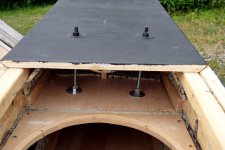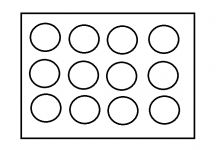And another thing, sort of on the same topic:
Since everybody always uses lots of internal bracing anyway, why the heck is the standard enclosure material Baltic Birch?
I'm not asking about alternative composites now, that was a different thread.
I mean, specifically, WHY NOT SPRUCE PLYWOOD?
Spruce has by far the highest stiffness-to-weight ratio of any of the woods commercially used for ply, and it's almost 1/3 the cost of BB.
Birch is a little bit stiffer, but also MUCH heavier. Again, if you're going to brace the snot out of it anyway, why not go with the lighter product, which is still extremely stiff, compared to standard Pine plywoods?
Plus, 3/4" Sitka Spruce (You only want Sitka or Norway) is as best I can tell, stiffer and lighter 1/2" Baltic. (though my figure may be a little off)
Anyway, you get my point.
And did I mention the price? Look for WISA Canadian Spruce ply. That's most likely Sitka, since that's what they have up there. It does seem a bit hard to source in the USA, though. These giuys sell it, but maybe not by the sheet: Plywood and Door
Look for WISA Canadian Spruce ply. That's most likely Sitka, since that's what they have up there. It does seem a bit hard to source in the USA, though. These giuys sell it, but maybe not by the sheet: Plywood and Door
Home Depot has “West Fraser” brand 4x8’ 3/4” Canadian Spruce plywood for $48 ! No idea what it's actually made of, though. (Probably slash Pine pulp and ground up Mexican workers)
Since everybody always uses lots of internal bracing anyway, why the heck is the standard enclosure material Baltic Birch?
I'm not asking about alternative composites now, that was a different thread.
I mean, specifically, WHY NOT SPRUCE PLYWOOD?
Spruce has by far the highest stiffness-to-weight ratio of any of the woods commercially used for ply, and it's almost 1/3 the cost of BB.
Birch is a little bit stiffer, but also MUCH heavier. Again, if you're going to brace the snot out of it anyway, why not go with the lighter product, which is still extremely stiff, compared to standard Pine plywoods?
Plus, 3/4" Sitka Spruce (You only want Sitka or Norway) is as best I can tell, stiffer and lighter 1/2" Baltic. (though my figure may be a little off)
Anyway, you get my point.
And did I mention the price?
Home Depot has “West Fraser” brand 4x8’ 3/4” Canadian Spruce plywood for $48 ! No idea what it's actually made of, though. (Probably slash Pine pulp and ground up Mexican workers)
Last edited:
Bruce Edgar gave a talk (a while ago ;-) ) and said he put sand on top of the cab and saw where it danced to identify resonance.
My current speakers move like a free barn door in a hurricane. I suspect big cabinets and less powerful motors are an easier combination to tame than strong motors in small cabs.
Grant.
My current speakers move like a free barn door in a hurricane. I suspect big cabinets and less powerful motors are an easier combination to tame than strong motors in small cabs.
Grant.
That's a good point, Pilover.
It's also another reason to opt for the most cone area possible, with any design.
I've also been thinking that, if one is trying to minimize weight, (a HUGE factor for me & my aging back) then one should use heavy, stiff material in the areas of highest compression (at the start of the horn) but can probably get away with lighter material at the end of the horn, and for certain sides of the enclosure.
(properly braced, of course.)
It's also another reason to opt for the most cone area possible, with any design.
I've also been thinking that, if one is trying to minimize weight, (a HUGE factor for me & my aging back) then one should use heavy, stiff material in the areas of highest compression (at the start of the horn) but can probably get away with lighter material at the end of the horn, and for certain sides of the enclosure.
(properly braced, of course.)
Bruce Edgar gave a talk (a while ago ;-) ) and said he put sand on top of the cab and saw where it danced to identify resonance.
My current speakers move like a free barn door in a hurricane. I suspect big cabinets and less powerful motors are an easier combination to tame than strong motors in small cabs.
Grant.
In general, smaller is stronger. As spans increase for a given material, less force is required for a certain displacement.
Birch is a little bit stiffer, but also MUCH heavier. Again, if you're going to brace the snot out of it anyway, why not go with the lighter product, which is still extremely stiff, compared to standard Pine plywoods?
Plus, 3/4" Sitka Spruce (You only want Sitka or Norway) is as best I can tell, stiffer and lighter 1/2" Baltic. (though my figure may be a little off)
Anyway, you get my point.
And did I mention the price?
Doubly true here.
In Australia, we have a sensible grading system for structural timber:
‘F’ grades F4 to F34: E.g. F14 indicates that the basic working stress (in bending) for that timber is around 14 MPa. Most native forest structural timbers such as white cypress and eucalypt hardwoods are graded using the F grade system
I can get birch that is rated F17 for $200 a sheet.
Birch is $$ cos it is pretty, and also because it is well traveled - all the taiga forests are in the other hemisphere.
In the same strength rating:
Basic F17 construction ply is $50.
F17 construction ply that is totally waterproof is also $50.
Hoop pine ply that's just as pretty as Birch is $100.
If I want to maximise strength to weight, cheap ply is available in grades up to F27. A light core corseted between thin layers of F27 braceply would be stronger than birch, at about half the price.
If I had a box I wanted to stiffen, adding a skin of the F27 braceply would be a good option.
I'm not sure if it is sold under that name in the USA, but presumably any storm prone area would stock "high strength hardwood ply for bracing timber frames" that would be similar.
I decided to rebuild a sub and was junking the old one today (keeping the driver though) . Here is an example of what I did for bracing. Lots of PL glue on joints, corners all reinforced with 2x2 and plywood brace which were screwed in place while the PL dried. It really didn't move a lot although I never played it what most people would call loud.
Grant.
Grant.
Attachments
Since stiffness goes up at the cube of thickness, one easy way to brace a closed box is to add very stiff panels to the exterior that cover at least ~71% of each panel.
The aforementioned threaded rod system is excellent also, especially when building Sonotube, etc., tube type subs to preload/compress all parts together to take max advantage of the tube's incredible axial stiffness.
GM
If stiffness goes up with the cube of the thickness of the panels, I wonder if it would be better to just glue on another layer of .75" plywood to the inside of the box making it 1.5" think with no bracing vs. .75 thick sides with bracing.
I would add the panels to the inside because the outside of these cabs look so damn good.
Making the sides twice as thick may take up much more room than bracing. I'll do some calculations.
Here is another thought. We all know that if we add a panel across the inside of a speaker that is loaded with holes, it will be just as strong but will take up less space. The load is in plane of the panel.
What if I glued the same panel to the inside of the wall of the sub-woofer cabinet, what it be as stiff as a solid piece of wood? It would still take up less space, but would the area of the cut out affect the stiffness and with the cutout there would still be more area available.
What if I glued the same panel to the inside of the wall of the sub-woofer cabinet, what it be as stiff as a solid piece of wood? It would still take up less space, but would the area of the cut out affect the stiffness and with the cutout there would still be more area available.
Attachments
I would add the panels to the inside because the outside of these cabs look so damn good.
Making the sides twice as thick may take up much more room than bracing. I'll do some calculations.
Inside, outside, it doesn't matter. With rare exception, 1" BB no void ply construction needs no bracing other than ensuring excellent joints, so double 0.75" wouldn't either.
Yes, weight, space savings is what makes bracing appealing.
GM
What if I glued the same panel to the inside of the wall of the sub-woofer cabinet, what it be as stiff as a solid piece of wood?
Good question and my SWAG is it won't be as strong since it's in flex mode unless it's thicker to offset the loss of surface area, but have never seen any info on the subject other than using solid panels with differing thickness and/or MOE specs.
GM
Here is another thought. We all know that if we add a panel across the inside of a speaker that is loaded with holes, it will be just as strong but will take up less space. The load is in plane of the panel.
What if I glued the same panel to the inside of the wall of the sub-woofer cabinet, what it be as stiff as a solid piece of wood? It would still take up less space, but would the area of the cut out affect the stiffness and with the cutout there would still be more area available.
The only problem I can see is how to determine the net volume (Vb). You'd probably have to either fill the empty enclosure with water, or just guestimate, then adjust your port (s) while measuring frequency.
But I like how it would minimize the largest "unbraced" area.
maybe its my imagination, but the thin Fomica outer layer on the old Karlson K15 seemed to stiffen things
One factor may have to do with "inequal resonant frequencies."
I'm a recording engineer / studio owner by trade. Many years ago I learned all facets of studio construction, from very serious books like Alton Everst and the BBC trade books. Obviously, with studio builds, minimizing sound transmission between rooms is critical.
An idea that was presented several times, both regarding wall construction and window construction, was to use two different materials that have different resonant frequencies. The idea was that when two such materials are touching each other, instead of getting both frequencies transmitted through the "sandwich," they actually null each other out to some degree.
I'm sure Art will be along momentarily to tell me that this is incorrect, but it IS the accepted theory.
So: A layer of formica over plywood. Yep.
Same for plywood, in general, since the many layers of glue will have a different res freq from the actual wood.
- Status
- This old topic is closed. If you want to reopen this topic, contact a moderator using the "Report Post" button.
- Home
- Loudspeakers
- Subwoofers
- how important is bracing???

